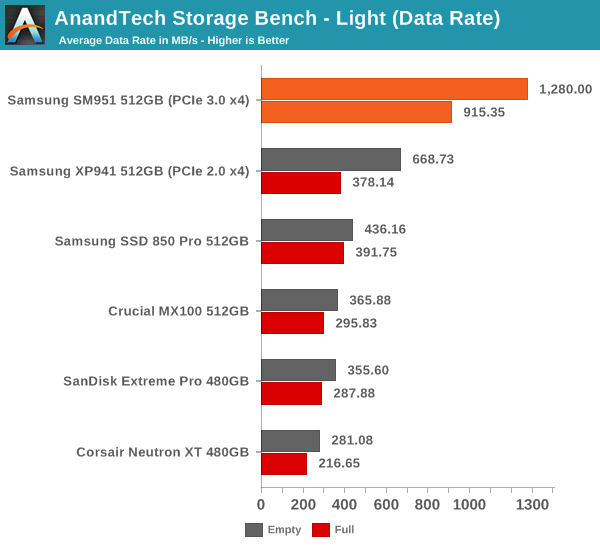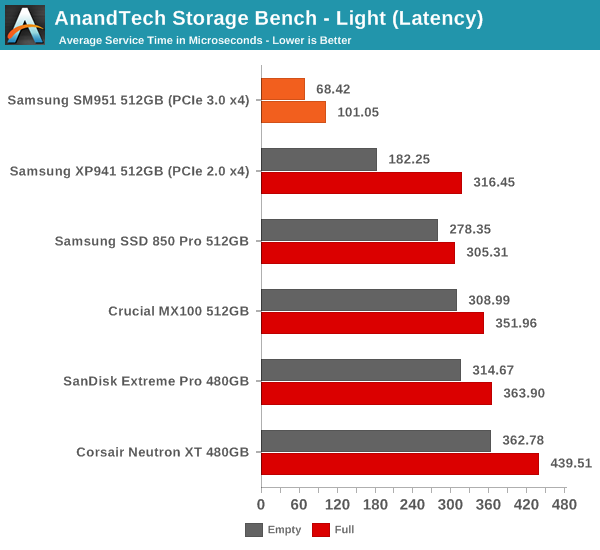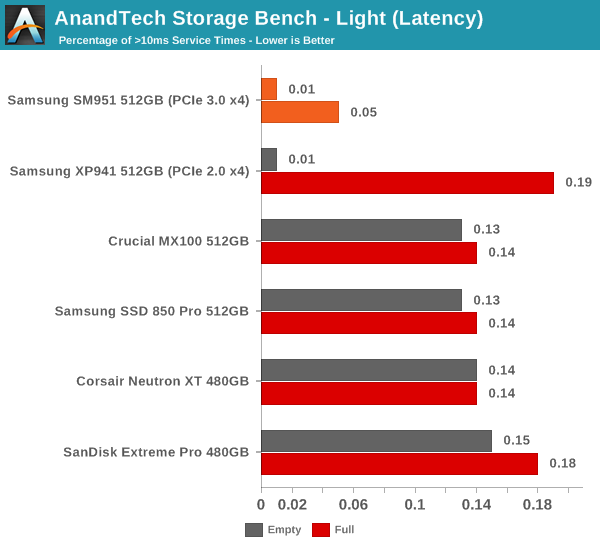Samsung SM951 (512GB) PCIe SSD Review
by Kristian Vättö on February 24, 2015 8:00 AM ESTAnandTech Storage Bench - Light
The Light trace is designed to be an accurate illustration of basic usage. It's basically a subset of the Heavy trace, but we've left out some workloads to reduce the writes and make it more read intensive in general.
| AnandTech Storage Bench - Light - Specs | ||||||||||||
| Reads | 372,630 | |||||||||||
| Writes | 459,709 | |||||||||||
| Total IO Operations | 832,339 | |||||||||||
| Total GB Read | 17.97 GB | |||||||||||
| Total GB Written | 23.25 GB | |||||||||||
| Average Queue Depth | ~4.6 | |||||||||||
| Focus | Basic, light IO usage | |||||||||||
The Light trace still has more writes than reads, but a very light workload would be even more read-centric (think web browsing, document editing, etc). It has about 23GB of writes, which would account for roughly two or three days of average usage (i.e. 7-11GB per day).
| AnandTech Storage Bench - Light - IO Breakdown | |||||||||||
| IO Size | <4KB | 4KB | 8KB | 16KB | 32KB | 64KB | 128KB | ||||
| % of Total | 6.2% | 27.6% | 2.4% | 8.0% | 6.5% | 4.8% | 26.4% | ||||
The IO distribution of the Light trace is very similar to the Heavy trace with slightly more IOs being 128KB. About 70% of the IOs are sequential, though, so that is a major difference compared to the Heavy trace.
| AnandTech Storage Bench - Light - QD Breakdown | ||||||||||||
| Queue Depth | 1 | 2 | 3 | 4-5 | 6-10 | 11-20 | 21-32 | >32 | ||||
| % of Total | 73.4% | 16.8% | 2.6% | 2.3% | 3.1% | 1.5% | 0.2% | 0.2% | ||||
Over 90% of the IOs have a queue depth of one or two, which further proves the importance of low queue depth performance.

The SM951 yet again provides roughly twice the data rate compared to the XP941 and with a full drive the difference is even more significant.

The same goes for average latency where the SM951's score is about one third of the XP941's. The SM951 can without a doubt boost performance with lighter IO loads as well, although in very light workloads the bottleneck tends to be the speed of user input (think about document creation for instance).











128 Comments
View All Comments
hojnikb - Tuesday, February 24, 2015 - link
Quick question;Is anyone going beyond that limit on 2D nand ?
Kristian Vättö - Tuesday, February 24, 2015 - link
I don't think anyone has stacked more than 16 dies currently. Right now Samsung is the only one shipping 16-die packages in volume, whereas others are either still developing or only shipping in very limited quantities (e.g. Toshiba's 16-die packages are ~3x more expensive in terms of $/GB).baii9 - Tuesday, February 24, 2015 - link
great review and new test suite, on the mx100 I mean. Clearly show that top tier ssds( 850 pro, extreme pro) is hardly better than a budget drive. would be awesome if you guys can throw arc 100 into the mix.Kristian Vättö - Tuesday, February 24, 2015 - link
I was only able to test a bunch of drives for this review and chose the drives that I found the most relevant, but the ARC 100 will definitely be tested soon.hojnikb - Tuesday, February 24, 2015 - link
yeah, that would be great.ARC 100 is getting cheaper every day here in EU and its currently the best buy in ~256GB segment.
danjw - Tuesday, February 24, 2015 - link
Since there are multiple form factors, it would be nice if you included the form factor for M.2 drives.Kristian Vättö - Tuesday, February 24, 2015 - link
It's mentioned right after the table, but I've also added it to the table now so it can't be missed.danjw - Tuesday, February 24, 2015 - link
Thanks!aggiechase37 - Tuesday, February 24, 2015 - link
Yeah, but if something goes terribly wrong with the drive, can we trust Samsung to do the right thing? Replace the 840 EVO's, or Samsung, you're dead to me.aggiechase37 - Tuesday, February 24, 2015 - link
So the only way to get a Samsung #fail drive is to get a Lenovo #spyware laptop? Let me just jump right all over that.